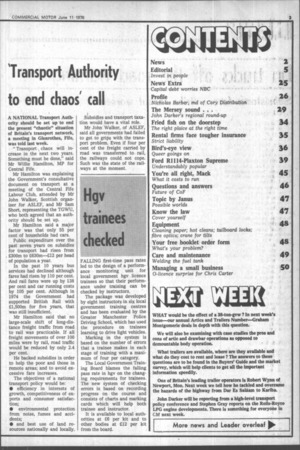'Transport Authority to end chaos' call
Page 5

If you've noticed an error in this article please click here to report it so we can fix it.
A NATIONAL Transport Authority should be set up to end the present "chaotic" situation of Britain's transport network, a meeting in Glenrothes, Fife, was told last week.
"Transport chaos will increase in the next two years. Something must be done," said Mr Willie Hamilton, MP for Central Fife.
Mr Hamilton was explaining the Government's consultative document on transport at a meeting of the Central Fife Labour Club, attended by Mr John Walker, Scottish organiser for ASLEF, and Mr Sam Short, representing the TGWU, who both agreed that an authority should be set up.
Mr Hamilton said a major factor was that only 55 per cent of households had cars.
Public expenditure over the past seven years on subsidies for transport had risen from £300m to £630m—£12 per head of population a year.
In the past 10 years bus services had declined although fares had risen by 110 per cent. And rail fares were up by 138 per cent and car running costs by 105 per cent. Although in 1974 the Government had supported British Rail with £1,500m for five years, that was still insufficient.
Mr Hamilton said that no large-scale shift of long-distance freight traffic from road to rail was practicable. If all freight movements of over 100 miles were by rail, road traffic would be reduced by only 2.4 per cent.
He backed subsidies in order to help the poor and those in remote areas; and to avoid excessive fare increases.
The objectives of a national transport policy would be: • efficiency in interests of growth, competitiveness of exports and consumer satisfaction; • environmental protection from noise, fumes and accidents; • and best use of land resources nationally and locally. Subsidies and transport taxation would have a vital role.
Mr John Walker, of ASLEF, said all governments had failed to get to grips with the transport problem. Even if four per cent of the freight carried by road was transferred to rail, the railways could not cope. Such was the state of the railways at the moment.
FALLING first-time pass rates led to the design of a performance monitoring unit for local government hgv licence trainees so that their performance under training can be checked by instructors.
The package was developed by eight instructors in six local government training centres and has been evaluated by the Greater Manchester Police Driving School, which has used the procedure on trainees learning to drive light vehicles.
Marking in the system is based on the number of errors that a trainee makes in each stage of training with a maximum of four per category.
The Local Government Training Board blames the falling pass rate in hgv on the changing requirements for trainees. The new system of checking errors is based on recording progress on the course and consists of charts and marking cards which will help both trainee and instructor.
It is available to local authorities at £6 per kit and to other bodies at £12 per kit from the board.




























































































